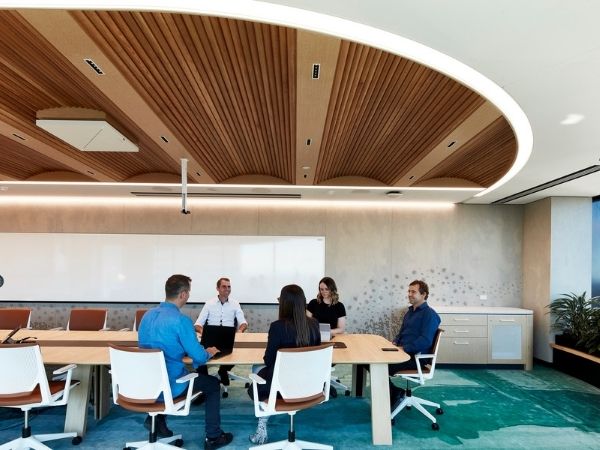
GroupGSA design of Microsoft HQ a game changer
Microsoft has unveiled its new Australian flagship office in North Sydney in the midst of the pandemic, offering a window into the future of workplace design.Microsoft has unveiled its new Australian flagship office in North Sydney in the midst of the pandemic, offering a window into the future of workplace design.
Located at 1 Denison Street, the 10,000sqm office will house 1400 employees over seven levels, consolidating the tech giant’s three offices in the Sydney CBD. Designed by GroupGSA, the office bucks many conventional trends of atypical office design. The practice has taken advantage of the fact that the company will be housed in one of the smartest buildings in Sydney, allowing for flexible work anytime, anywhere.

Ashish Mehrotra, Microsoft’s Head of Real Estate and Facilities in Asia Pacific, says the pandemic has outlined that engagement and productivity has remained unaffected, nor is it a barrier to having a thriving company culture.
“Our new space at 1 Denison St breaks the traditional mould of what an office can and should be,” he says.
“This is clearly shown in the design of the new space, where remote and in-person workers are on equal footing.”

Channelling some of the country’s most iconic landscapes and home to views of Sydney Harbour, GroupGSA Principal and project lead Pablo Albani says the journey to an employee’s desk and meeting spaces is an experiential one.
“To get to the areas of work, you have to traverse different elements, like enclosed and semi-enclosed spaces, cave-like environments and tunnels of greenery,” he says.
A timber wall on the 28th floor is reminiscent of the Royal National Park. Referencing the Figure Eight Pools with rippling effects on the ceiling, other surfaces embody the shimmer of Australian beaches. The floor also contains a distinctive rock wall that mimics Cradle Mountain. On Level 26, indistinct way-finding is inlaid on the floor that imitates the typography of the Blue Mountains.

“As people walk in, we want them to be fully immersed — in the brand and in the environment,” says GroupGSA Associate Director and Lead Designer, Jessica Margiotta.
Intelligent lighting, robotics and advanced workplace occupancy sensors linked to Microsoft platforms are a key part of Microsoft’s hybrid office experience. The practice utilised a number of Microsoft technologies, such as the company’s VR and HoloLens technologies, for the clients to experience the space before it was constructed.

A Corian-clad staircase with built-in LEDs cantilevers into the void between the seven floors, encouraging connectivity and collaboration. The lights possess the ability to be changed to suit the overall aesthetic, be coloured for themed events, or to even mimic the weather.
Smart office sensors and digital whiteboards allow employees to contribute in a way that best suits them. The building’s capabilities gives employees the ability to book a number of amenities via the 1 Denison app. The app can be utilised for employees to order and pay for food, book a massage or schedule a barre or yoga class at the building’s wellness centre, The Nest. Modern maintenance facilities include cleaning robots which traverse the floors.
“We know that employees still want and need a physical space to come together and connect,” Mehrotra says.

“An open space, concierge at arrival, communal dining area, an onsite barista, and grab-and-go food options prompt people to meet, eat, collaborate, and socialise. There are also areas for board games and flex spaces that adapt to varying purposes or sports watching nights.”
Much of Level 28’s floorspace is dedicated to staff amenities and functions. It features a live stream room, Xbox gaming room, a recording studio, dedicated meditation and yoga spaces, a library and parents’ room. There are two ‘nap suites’, prayer rooms and a leisure hub for employees to have a game of pool or ping pong.
Mehrotra says each floor individually serves the needs of Microsoft’s diverse range of employees.
“They can choose quiet corners for solo work, comfortable sofas for informal meetings, and reservable meeting rooms for more involved sessions. Team neighbourhoods, screened-in workshop areas, touch-down desks, sound-proofed phone booths, and conversation rooms all work together to support today’s mobile workforce.”

Responding to the conventions of the post-pandemic workplace, GroupGSA’s response includes a minimum of 1.5m spacing at all work points, hand sanitation stations and no-touch automatic door operation using swipe controls.
Margiotta says tech companies, like Microsoft, need their talent to be constantly stimulated, future-focussed and pushing boundaries. Key to this is good workplace design.
“Microsoft’s new flagship office in Australia changes the perspective on what a workspace is and how it functions,” she says.
“The result is a workplace design that inspires its employees to create the extraordinary.”



